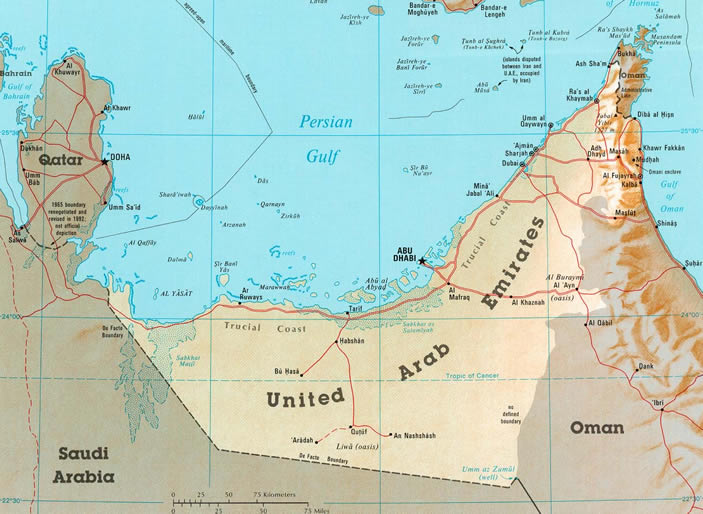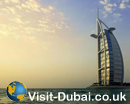The U.A.E shares borders with the small independent State of Qatar to the north-west, Oman to the east and north-east and its largest neighbour, by far, Saudi Arabia, to the south and south-west.
Six of the U.A.E Sheikhdoms, viz. Abu Dhabi [or Abu Zaby], Dubai [or Dubayy], Sharjah, Ajman, Umm al Quwain [Umm al Qaywayn] and Ras Al Khaimah [Ra's al Khaymah] are found on the north coast of the Arabian Peninsula, along the Arabian Gulf, whilst the seventh, Fujairah [ Al Fujayrah] is located outside the Arabian Gulf, sitting on the east coast on the shores of the Gulf of Oman. This is part of the Arabian Sea, which is, in turn, part of the larger Indian Ocean.
The Arabian Gulf/Persian Gulf, is bordered by Iran, formerly known as Persia, to the east and north-east. Then, at the northern end of the Arabian Gulf lie the independent Islamic states of Iraq and Kuwait. Heading south from Kuwait on the western shore, the Gulf is bounded, first by the large, oil-rich State of Saudi Arabia, then, linked by the King Fahad Causeway, the small, independent island state of Bahrain, which consists of an archipelago of 33, sometimes tiny, low-lying islands.
Just south of Bahrain, is the independent peninsular state of Qatar, jutting northwards into the waters of the Gulf.
South and east of Qatar, you then reach the United Arab Emirates [U.A.E], consisting of seven separate emirates unified as one State since 1971.
As you follow the coast around, the first of the United Arab Emirates encountered is Abu Dhabi, also known as Abu Zaby. The latter is the name you will see in many atlases, notably the popular National Geographic.
Abu Dhabi/Abu Zaby, in terms of area, is largely desert. In fact, most of the land area of the United Arab Emirates, which covers 83,600 square miles [10.5 times the area of Wales.], is in the emirate of Abu Dhabi. Much of it forms part of the Rub Al Khali, or Empty Quarter, a desert that stretches through Saudi Arabia and Oman, as well. This arid stark desert is renowned for its spectacular sand dunes, broken only by the occasional oasis.
Visitors to Abu Dhabi will find a land of startling contrasts-- occasional irrigated areas of cultivated farmland appear as a green paradise amid endless stretches of desert and vast tracts of sabkha, or salt pans.
Abu Dhabi City is located on a low-lying island in the Arabian Gulf. It is a lush modern metropolis, complete with tree-lined streets, futuristic sky-scrapers, huge shopping malls and international luxury hotels, surrounded by the sparkling waters of the Arabian Gulf. The famous "Manhattan" style skyline, reflected in the azure waters along the corniche, offers a striking contrast to the large parks and green boulevards that are spread across the island. Abu Dhabi City is the capital of the United Arab Emirates.
Al Ain, the second city of Abu Dhabi, lies to the east, on the border with Oman. Primarily an oasis town that is surrounded by a hostile desert, this "Garden City" as it is also known, portrays a vision of cool tranquility.
North east of Abu Dhabi/ Abu Zaby, as the coast curves around, is the astonishingly rapidly developing emirate of Dubai, then the smaller emirates of Sharjah followed by Ajman as you carry on northwards towards the Strait of Hormuz at the mouth of the Persian/Arabian Gulf. About 50 miles north of the Strait of Hormuz lies the large Islamic Republic of Iran, which was known as the kingdom of Persia until the overthrow of the Shah of Persia in 1979. Iran occupies the whole of the northern coast of the Gulf.
After Ajman, on the southern shore, you reach the small Arab emirates of Umm Al Quwain, followed by Ras Al Khaimah. Then , heading further north, you leave the U.A.E at the rocky Musandam Peninsula overlooking the Strait of Hormuz and enter the independent, more mountainous, country of Oman.
The majestic Hajar Mountains rise in the Mussandam Peninsula, run through the eastern U.A.E, and flow into Oman, further south. Oman is split into two parts, separated by the U.A.E, and the emirate of Fujairah.
The Persian Gulf, or the Arabian Gulf, as all the Arab countries like it to be known, is the foremost oil producing area in the world, apart from, possibly, Russia. Abundant oil and natural gas has made many of the countries surrounding the Gulf very wealthy. Kuwait, Bahrain, Qatar Saudi Arabia and Abu Dhabi in the U.A.E are particularly well blessed with oil and gas reserves.
Dubai has also been fortunate in the past in terms of oil reserves, but those reserves are now beginning to dwindle, so there is a huge drive to turn the emirate into a premier global tourist destination over the next few years. They are busily setting up the infrastructure for this transformation.
The speed of change is absolutely amazing!! The spectacular, high quality, civil engineering projects being created in Dubai in pursuit of this ambitious tourism goal, are truly astounding. What is occurring in Dubai requires a whole dictionary of superlatives!
Three huge palm-shaped islands, Palm Jumeirah, Palm Jebel Ali and Palm Deira, are being created from dredged sea-floor sand off the coast of Dubai. Not content with that,"The World", which is a collection of over 300 man-made islands, created over two miles off-shore from dredged sand, all in the shape of a map of the world, is absolutely mind-boggling!!
Dubai is an astounding place! It is not only growing at a truly phenomenal speed; it is the scale, design and sheer quality of the new developments that is making the world sit up in astonishment! They can only be described as grandiose!
Dubai not only has the largest marina in the world [Dubai Marina], the largest man-made harbour [at Jebel Ali], the biggest artificial island and largest motorway intersection, it also has the world's tallest hotel, the spectacularly designed, 1053 feet high, Burj-al-Arab, the only 7-star hotel in the world [see www.burj-al-arab.co.uk]!
Beautifully shaped like the billowing sail of an Arab dhow and built on its own man-made island surrounded by the warm
turquoise waters of the Arabian Gulf, it is a truly global architectural icon. It represents Dubai, symbolically, like the Sydney
Opera House represents Sydney and the Eiffel Tower [see eiffel-tower.co.uk ], Paris.
Access to Burj al Arab is via a causeway,courtesy of a Rolls Royce, or by helicopter. The Burj-al-Arab is dazzling white by day and rainbow-coloured by night, when its facade is used as a canvas for spectacular light displays. Thirty types of marble and 86,111 square feet of 22 carat gold leaf are incorporated in the décor. It is pure luxury!
Not content with having the tallest hotel in the world, Dubai is now constructing the two tallest towers in the world, which
will dwarf all others globally.
The first of these towers, the Burj Dubai, will be completed in November 2008. It will be at least 807.7metres or 2650 feet in height when finished. It has already surpassed the previous record of 1671 feet [509 metres] held by the "Taipei 101 Tower" in Taipei, Taiwan.
However, the second Dubai skyscraper, the Al Burj Tower, being constructed by Nakheel, the adventurous and highly
innovative Dubai Government owned civil engineering company, will be even taller. Some even suggest that Al Burj could
end up a kilometre, [1000 metres ] high, but that has not been officially announced. We shall see!
To put the Burj Dubai and Al Burj Towers in perspective, one needs to remember that New York's iconic Empire State Building is a mere 1200 feet high. The Burj Dubai alone will be over twice that height! Astonishing!!
Before Dubai's rise to prominence as a trading and tourism hotspot, its Emirate neighbour, Sharjah, was one of the wealthiest towns in the region, with settlers earning their livelihood from fishing, pearling and trade. The city grew inland from the original creekside town, but the creek remains a prominent landmark today.
Sharjah is well worth visiting for its various interesting museums and great shopping. In 1998, UNESCO named Sharjah the cultural capital of the Arab world, due to its commitment to art, culture and preserving its traditional heritage. Sharjah is the only emirate with coastline on both the Arabian Gulf and Gulf of Oman. The highway which links the two coasts heads through the spectacular, bare, very rocky, Hajar Mountains, a landscape which contrasts completely with the flat, low-lying coastline of the U.A .E along the Arabian Gulf from Sharjah to Abu Dhabi.
The emirate of Ajman is the smallest of the seven emirates and is situated about 160km to the north-east of Abu Dhabi.
Known as a coastal emirate, it also has two inland enclaves, one at Masfut on the edge of the Hajar Mountains and one at
Manama, between Sharjah and Fujairah. Ajman is noted for having one of the biggest
dhow building centres in the region. A visit here is a great chance to see these massive, traditional wooden boats being built with rudimentary tools, using skills passed down
through the generations. This quiet emirate has some great beaches and a pleasant
Corniche.
Umm Al Quwain is the second smallest of the emirates, and has the smallest
population. Nestled on the coast between Ajman and Ras Al Khaimah, it's a quiet
place where little had changed over the years. The main industries are fishing and date
cultivation. However, things are beginning to change, with new tourism and housing
developments in the offing.
Ras Al Khaimah is the most northern of the seven emirates, but thanks to the new Emirates Road extension, you can make the trip from Dubai in less than an hour.
With the majestic Hajar Mountains rising just behind the city and the Arabian Gulf stretching out from the shore, Ras Al Khaimah [RAK] has possibly the best scenery of any city in the U.A.E. A creek divides the city into the old town, Ras Al Khaimah proper, and the newer Al Nakheel district. Although relatively unknown and undiscovered, RAK is reinventing and rebranding itself, with the aim of becoming a popular tourism destination in future. New tourism projects are in the process of development.
The Emirate of Fujairah is not on the Arabian Gulf. It is entirely located on the East Coast of the Arabian Peninsula, on the Gulf of Oman, sandwiched between the two parts of the independent State of Oman.
Fujairah was actually part of the Emirate of Sharjah until 1952, making it the youngest of the seven emirates.
With its golden beaches bordering the Gulf of Oman on the one side and the rugged Hajar Mountains behind, it is worth a visit.
Fujairah is a busy trading centre, with a modern container port and a thriving Free Zone attracting major companies from around the world.
Off the coast, the seas and coral reefs make a great spot for fishing, diving and watersports. It is also a great place for birdwatching during the Spring and Autumn migrations, as it is on the route from Africa to Central Asia.
The emirate has started to encourage more tourism in recent years, by opening new hotels and providing more recreational facilities.
The United Arab Emirates is a fascinating country to visit, especially during the winter months, when the Arabian Gulf area experiences very pleasant, warm weather, whilst much of Europe shivers.
There are great contrasts in scenery and in the level of development between the various sheikhdoms comprising the United Arab Emirates, making the U.A.E a truly wonderful place for a holiday!





